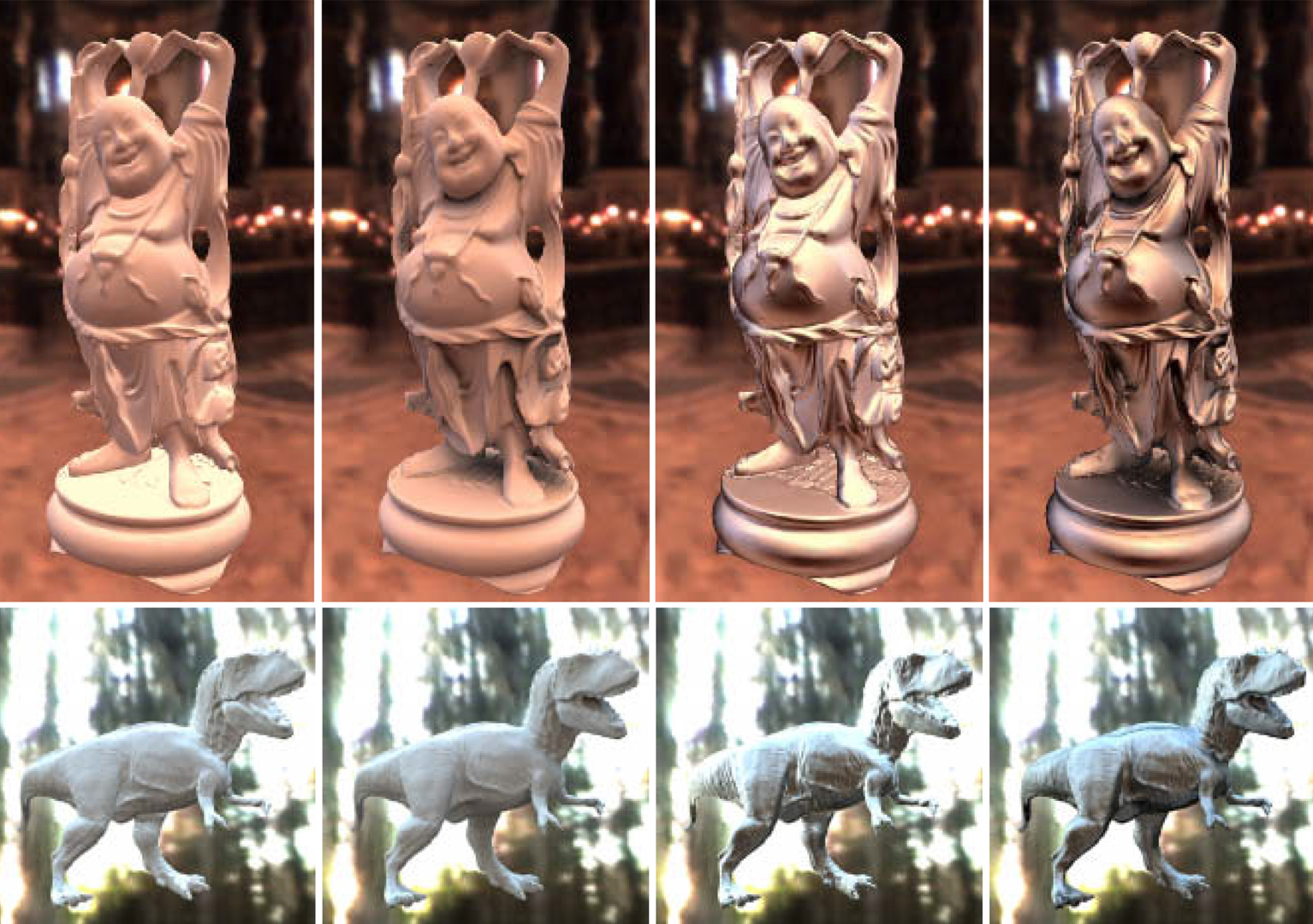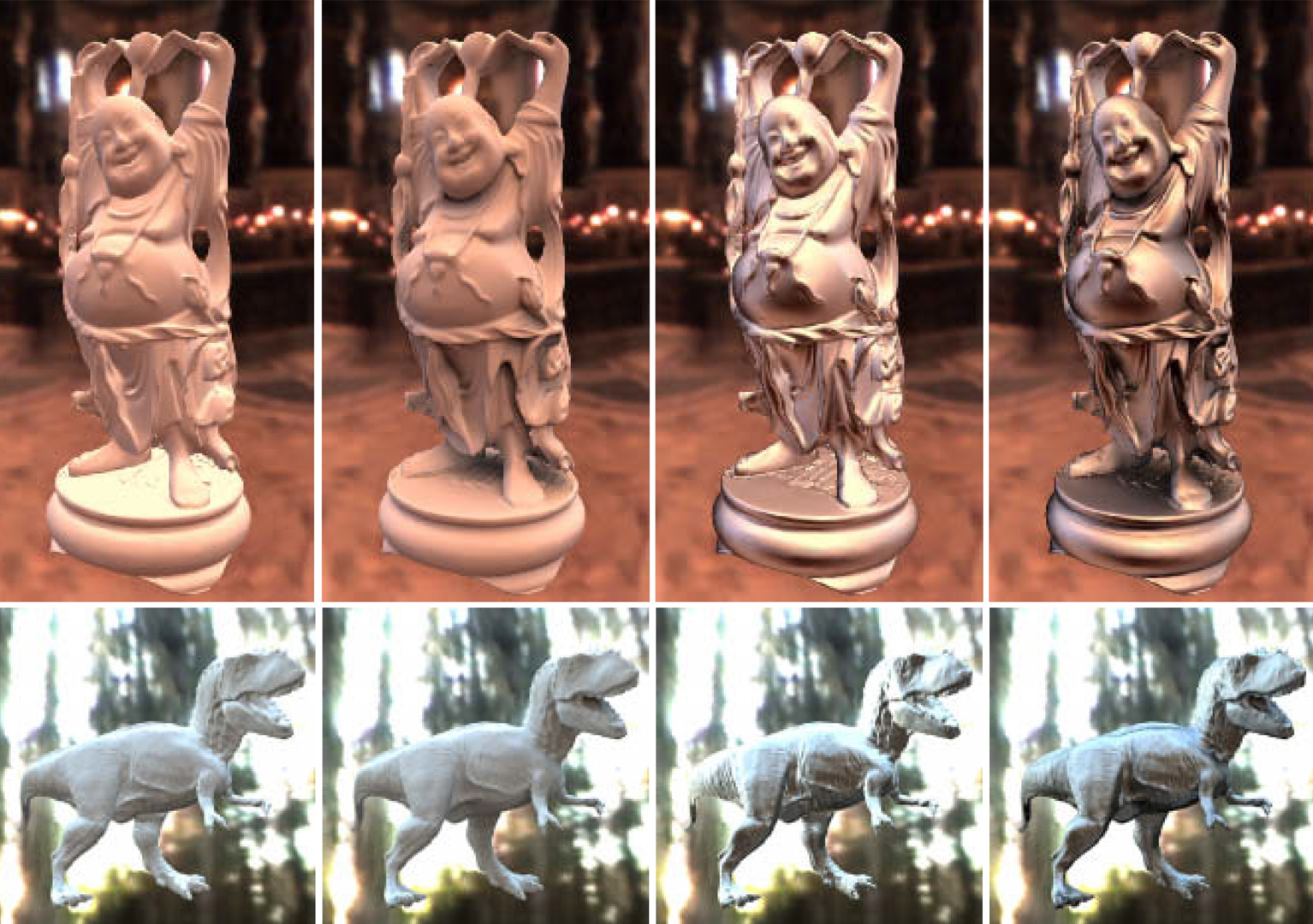“Precomputed radiance transfer for real-time rendering in dynamic, low-frequency lighting environments”
Conference:
Type(s):
Title:
- Precomputed radiance transfer for real-time rendering in dynamic, low-frequency lighting environments
Presenter(s)/Author(s):
Abstract:
We present a new, real-time method for rendering diffuse and glossy objects in low-frequency lighting environments that captures soft shadows, interreflections, and caustics. As a preprocess, a novel global transport simulator creates functions over the object’s surface representing transfer of arbitrary, low-frequency incident lighting into transferred radiance which includes global effects like shadows and interreflections from the object onto itself. At run-time, these transfer functions are applied to actual incident lighting. Dynamic, local lighting is handled by sampling it close to the object every frame; the object can also be rigidly rotated with respect to the lighting and vice versa. Lighting and transfer functions are represented using low-order spherical harmonics. This avoids aliasing and evaluates efficiently on graphics hardware by reducing the shading integral to a dot product of 9 to 25 element vectors for diffuse receivers. Glossy objects are handled using matrices rather than vectors. We further introduce functions for radiance transfer from a dynamic lighting environment through a preprocessed object to neighboring points in space. These allow soft shadows and caustics from rigidly moving objects to be cast onto arbitrary, dynamic receivers. We demonstrate real-time global lighting effects with this approach.
References:
1. AGRAWALA, M, RAMAMOORTHI, R, HEIRICH, A, AND MOLL, L, Efficient Image-Based Methods for Rendering Soft Shadows, SIGGRAPH ’00, 375-384. Google Scholar
2. AIREY, J, ROHLF, J, AND BROOKS, F, Towards Image Realism with Interactive Update Rates in Complex Virtual Building Environments,1990 Symposium on Interactive 3D Graphics, 24(2), 41-50. Google Scholar
3. ASHIKHMIN, M, AND SHIRLEY, P, Steerable Illumination Textures, ACM Transactions on Graphics, 2(3), to appear. Google Scholar
4. CABRAL, B, MAX, N, AND SPRINGMEYER, R, Bidirectional Reflection Functions from Surface Bump Maps, SIIGRAPH ’87, 273-281. Google Scholar
5. CABRAL, B, OLANO, M, AND NEMEC, P, Reflection Space Image Based Rendering, SIGGRAPH ’99, 165-170. Google Scholar
6. COHEN, M, AND WALLACE, J, Radiosity and Realistic Image Synthesis, Academic Press Professional, Cambridge, 1993. Google Scholar
7. COOK, R, PORTER, T, AND CARPENTER, L, Distributed Ray Tracing, SIGGRAPH ’84, 137-146. Google Scholar
8. DEBEVEC, P, Rendering Synthetic Objects into Real Scenes: Bridging Traditional and Image-Based Graphics with Global Illumination and High Dynamic Range Photogaphy, SIGGRAPH ’98, 189-198. Google Scholar
9. DEBEVEC, P, HAWKINS, T, TCHOU, C, DUIKER, H, SAROKIN, W, AND SAGAR, M, Acquiring the Reflectance Field of a Human Face, SIGGRAPH 2000, 145-156. Google Scholar
10. DOBASHI, Y, KANEDA, K, NAKATANI, H, AND YAMASHITA, H, A Quick Rendering Method Using Basis Functions for Interactive Lighting Design, Eurographics ’95, 229-240.Google Scholar
11. DORSEY, J, SILLION, F, AND GREENBERG, D, Design and Simulation of Opera Lighting and Projection Effects, SIGGRAPH ’91, 41-50. Google Scholar
12. D’ZMURA, M, Shading Ambiguity: Reflection and Illumination. In Computational Models of Visual Processing (1991), Landy and Movshon, eds., MIT Press, Cambridge, 187-207.Google Scholar
13. EDMONDS, A, Angular Momentum in Quantum Mechanics, Princeton University, Princeton, 1960.Google Scholar
14. GREENE, N, Environment Mapping and Other applications of World Projections, IEEE CG&A, 6(11):21-29, 1986. Google Scholar
15. GREGER, G, SHIRLEY, P, HUBBARD, P, AND GREENBERG, D, The Irradiance Volume, IEEE Computer Graphics And Applications, 6(11):21-29, 1986.Google Scholar
16. HAKURA, Z, AND SNYDER, J, Realistic Reflections and Refractions on Graphics Hardware with Hybrid Rendering and Layered Environment Maps, Eurographics Workshop on Rendering, 2001, 289-300. Google Scholar
17. HAEBERLI, P, AND AKELEY, K, The Accumulation Buffer: Hardware Support for High-Quality Rendering, SIGGRAPH ’90, 309-318. Google Scholar
18. HEIDRICH, W, LENSCH, H, COHEN, M, AND SEIDEL, H, Light Field Techniques for Reflections and Refractions, Eurographics Rendering Workshop 99, 195-375.Google Scholar
19. HEIDRICH, W, SEIDEL H, Realistic, Hardware-Accelerated Shading and Lighting, SIGGRAPH ’99, 171-178. Google Scholar
20. HEIDRICH, W, DAUBERT, K, KAUTZ, J, AND SEIDEL, H, Illuminating Micro Geometry based on Precomputed Visibility, SIGGRAPH ’00, 455-464. Google Scholar
21. JENSEN, H, Global Illumination using Photon Maps, Eurographics Workshop on Rendering 1996, 21-30. Google Scholar
22. JENSEN, H, MARSCHNER, S, LEVOY, M, AND HANRAHAN, P, A Practical Model for Subsurface Light Transport, SIGGRAPH ’01, ‘511-518. Google Scholar
23. KAUTZ, J, AND MCCOOL, M, Interactive Rendering with Arbitrary BRDFs using Separable Approximations, Eurographics Workshop on Rendering 99,.247-260. Google Scholar
24. KAUTZ, J, VAZQUEZ, P, HEIDRICH, W, AND SEIDEL, H, A Unified Approach to Prefiltered Environment Maps, Eurographics Workshop on Rendering 2000, 185-196. Google Scholar
25. KAJIYA, J, The Rendering Equation, SIGGRAPH ’86, 143-150. Google Scholar
26. KEATING, B, AND MAX, N, Shadow Penumbras for Complex Objects by Depth-Dependent Filtering of Multi-Layer Depth Images, Eurographics Rendering Workshop, 1996, pp.205-220. Google Scholar
27. KELLER, A, Instant Radiosity, SIGGRAPH ’97, 49-56. Google Scholar
28. LINDE, Y, BUZO, A, AND GRAY, R, An algorithm for Vector Quantizer Design, IEEE Transactions on Communication COM-28, 1980,84-95.Google Scholar
29. LOKOVIC, T, AND VEACH, E, Deep Shadow Maps, SIGGRAPH ’00, pp.385-392. Google Scholar
30. MALZBENDER, T, GELB, D, AND WOLTERS, H, Polynomial Texture Maps, SIGGRAPH ’01, 519-528. Google Scholar
31. MAX, N, Horizon Mapping: Shadows for Bump-Mapped Surfaces, The Visual Computer, July 1998, 109-117. Google Scholar
32. MILLER, G, Efficient Algorithms for Local and Global Accessibility Shading, SIGGRAPH ’94, 319-326. Google Scholar
33. NIMEROFF, J, SIMONCELLI, E, AND DORSEY, J, Efficient Re-rendering of Natural Environments, Eurographics Workshop on Rendering 1994, 359-373.Google Scholar
34. RAMAMOORTHI, R, AND HANRAHAN, P, An Efficient Representation for Irradiance Environment Maps, SIGGRAPH ’01, 497-500. Google Scholar
35. REEVES, W, SALESIN, D, AND COOK, R, Rendering Antialiased Shadows with Depth Maps, SIGGRAPH ’87, ‘283-291. Google Scholar
36. SEGAL, M, KOROBKIN, C, VAN WIDENFELT, R, FORAN, J, AND HAEBERLI, P, Fast Shadows and Lighting Effects Using Texture Mapping, SIGGRAPH ’92, ‘249-252. Google Scholar
37. SCHRÖDER, P, AND SWELDENS, W, Spherical Wavelets: Efficiently Representing the Sphere, SIGGRAPH ’95, ‘161 – 172. Google Scholar
38. SILLION, F, ARVO, J, WESTIN, S, AND GREENBERG, D, A Global Illumination Solution for General Reflectance Distributions, SIGGRAPH ’91, 187-196. Google Scholar
39. SOLER, C, AND SILLION, F, Fast Calculation of Soft Shadow Textures Using Convolution, SIGGRAPH ’98, ‘321-332. Google Scholar
40. TEO, P, SIMONCELLI, E, AND HEEGER, D, Efficient Linear Re-rendering for Interactive Lighting Design, October 1997 Report No. STAN-CS-TN-97-60, Stanford University, 1997. Google Scholar
41. WARD, G, RUBINSTEIN, F, AND CLEAR, R, A Ray Tracing Solution for Diffuse Interreflection, SIGGRAPH ’88, ’85-92. Google Scholar
42. WESTIN, S, ARVO, J, TORRANCE, K, Predicting Reflectance Functions from Complex Surfaces, SIGGRAPH ’92, 255-264. Google Scholar
43. WILLIAMS, L, Casting Curved Shadows on Curved Surfaces, SIGGRAPH ’78, 270-274. Google Scholar
44. ZARE, R, Angular Momentum: Understanding Spatial Aspects in Chemistry and Physics, Wiley, New York, 1987.Google Scholar





